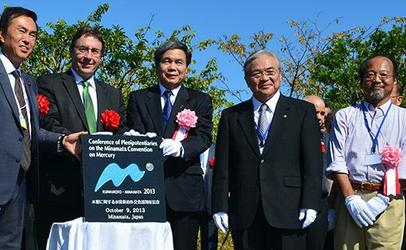
KUMAMOTO, Japan, October 10, 2013 (ENS) – Japan, where residents of Minamata suffered lethal mercury poisoning in the mid-1950s, today became one of the first countries to sign a new international treaty to reduce mercury emissions and to phase out many products containing the toxic metal.
The Minamata Convention on Mercury, a global, legally binding treaty agreed by governments in January, was today formally adopted as international law. The convention has been adopted by 139 governments and signed by 87 governments, including Japan.
The convention provides for controls and reductions across a range of products, processes and industries where mercury is used, released or emitted. The treaty addresses the direct mining of mercury, export and import of the metal, and safe storage of waste mercury.
Now open for signature by all the world’s governments, the new treaty is the first new global convention on environment and health for close to a decade.

Over 1,000 delegates are taking part in the diplomatic conference at Hotel Nikko in Kumamoto and in Minamata from October 9 to 11. It is the culmination of years of international negotiations since global action on mercury was first agreed to at the UN Environment Programme’s Governing Council meeting in 2009.
“Mercury has some severe effects, both on human health and on the environment,” said UNEP Executive Director Achim Steiner. “UNEP has been proud to facilitate and support the treaty negotiation over the past four years because almost everyone in the world – be they small-scale gold miners, expectant mothers or waste-handlers in developing countries – will benefit from its provisions.”
Mercury’s impacts on the human nervous system have been known for more than a century. Exposure to mercury also can impair thyroid and liver function and cause irritability, tremors, disturbances to vision, memory loss and cardiovascular problems. In extreme cases, insanity, paralysis, coma, and death follow within weeks of the onset of symptoms.
On Wednesday, delegates held a ceremonial opening of the diplomatic conference in Minamata, the city where many local people were poisoned after eating mercury-contaminated seafood from Minamata Bay.
The seafood was contaminated by the release of methylmercury in the industrial wastewater from the Chisso Corporation’s chemical factory from 1932 to 1968. The mercury bioaccumulated in shellfish and fish in Minamata Bay and the Shiranui Sea to toxic concentrations. The neurological syndrome caused by severe mercury poisoning now is known as Minamata Disease.
The city of Minamata that delegates visited Wednesday has used the years since the public health disaster of the mid-20th century to remodel itself as an eco-city with internationally recognized recycling and environmental programs.
“The Minamata Convention will protect people and improve standards of living for millions around the world, especially the most vulnerable,” said UN Secretary General Ban Ki-moon in an address read to the conference. “Let us strive to achieve universal adherence to this valuable new instrument, and advance together toward a safer, more sustainable and healthier planet for all.”
Under the Minamata Convention, governments have agreed on a list of products containing mercury whose production, import and export will be banned by 2020. These items have non-mercury alternatives that will be phased in as those containing mercury are phased out.
They include:
- Batteries, except for button cell batteries used in implantable medical devices
- Switches and relays
- Some compact fluorescent lamps
- Mercury in cold cathode fluorescent lamps and external electrode fluorescent lamps
- Soaps and cosmetics that use mercury as a skin whitener
- Some mercury-containing medical items such as thermometers and blood pressure devices.
Mercury from small-scale gold-mining and from coal-fired power stations represent the biggest sources of mercury pollution worldwide. Miners inhale mercury during smelting, and mercury run-off into rivers and streams contaminates fish, the food chain and people downstream.

Under the Minamata Convention, governments have agreed that countries will draw up strategies to reduce the amount of mercury used by small-scale miners and that national plans will be drawn up within three years of the treaty entering into force to reduce or eliminate mercury.
The Convention will also control mercury emission and releases from industrial plants such as coal-fired power stations, industrial boilers, waste incinerators and cement clinkers facilities.
At a time when some multilateral negotiations have been difficult, UN officials say that the successful negotiation of the Minamata Convention provides a new momentum to intergovernmental cooperation on the environment. They observe that many countries, despite financial constraints, remained prepared to commit resources to combating the harmful effects of mercury.
Pinpointing populations at risk, boosting medical care and better training of health care professionals in identifying and treating the effects of mercury exposure are expected to result from adherence to the obligations of the new treaty.
“With the signing of the Minamata Convention on Mercury we will be going a long way in protecting the world forever from the devastating health consequences from mercury,” said Dr. Margaret Chan, director-general of the World Health Organization. “Mercury is one of the top 10 chemicals of major public health concern and is a substance which disperses into and remains in ecosystems for generations, causing severe ill health and intellectual impairment to exposed populations.”
Copyright Environment News Service (ENS) 2013. All rights reserved.
© 2013, Environment News Service. All rights reserved. Content may be quoted only with proper attribution and a direct link to the original article. Full reproduction is prohibited.
